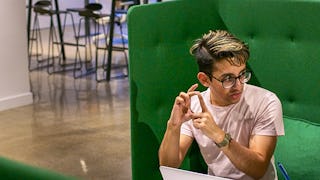Design a User Experience for Social Good and Prepare for Jobs is the seventh course in a program that will equip you with the skills you need to become an entry-level UX designer. In this course, you will design a dedicated mobile app and a responsive website focused on social good. You will showcase all that you’ve learned during the certificate program to complete the design process from beginning to end: empathizing with users, defining their pain points, coming up with ideas for design solutions, creating wireframes and prototypes, and testing designs to get feedback. By the end of this course, you will have a new cross-platform design project to include in your professional UX portfolio.

4 days left: Get a Black Friday boost with $160 off 10,000+ programs. Save now.


Design a User Experience for Social Good & Prepare for Jobs
This course is part of Google UX Design Professional Certificate

Instructor: Google Career Certificates
222,811 already enrolled
Included with
(4,963 reviews)
What you'll learn
Apply each step of the UX design thinking framework (empathize, define, ideate, prototype, test) to create a project focused on social good.
Build wireframes, mockups, and low-fidelity and high-fidelity prototypes for a dedicated mobile app and a responsive website.
Prepare to successfully interview for an entry-level UX design job.
Gain a competitive edge by learning AI skills from Google experts
Skills you'll gain
Details to know

Add to your LinkedIn profile
See how employees at top companies are mastering in-demand skills

Build your Design and Product expertise
- Learn new concepts from industry experts
- Gain a foundational understanding of a subject or tool
- Develop job-relevant skills with hands-on projects
- Earn a shareable career certificate from Google

There are 3 modules in this course
You've reached the final course of the Google UX Design Certificate — congratulations! You will design a dedicated mobile app and a responsive website focused on social good that showcases everything you've learned in the program. To get started, you'll learn about designing across devices by exploring progressive enhancement and graceful degradation approaches and the 4Cs. With all of this new knowledge, you’ll begin your portfolio project. You’ll start with the empathize phase, where you’ll create personas, user stories, and user journey maps. Then, you’ll move on to the define phase, where you’ll identify the user need your project will focus on and build a problem statement. Finally, you’ll make your way into the ideate phase, where you’ll conduct a competitive audit and come up with ideas for your dedicated mobile app design through sketching.
What's included
7 videos6 readings3 assignments2 plugins
As the digital world continues to expand, companies recognize that designing good user experiences is a necessity, which is why UX design is a high-growth and in-demand job field. The key to landing one of those UX design jobs is a strong portfolio and online presence. In this part of the course, you'll start to create a portfolio to showcase your upcoming work. You'll also learn about the importance of having a personal brand and building an online presence.
What's included
15 videos10 readings5 assignments
In the final part of the Google UX Design Certificate, you’ll prepare to find a job as a new UX designer. You’ll start by making final adjustments to your portfolio to ensure it’s ready to share in job applications. Next, you’ll examine the UX design interview process and develop strategies to succeed in various types of interview: pre-interview research, an elevator pitch, a phone screen, a portfolio presentation, a whiteboard exercise, a take home design exercise, and more. Finally, you’ll explore the world of freelancing by creating a business plan and learning how to land your first client.
What's included
18 videos17 readings4 assignments1 plugin
Earn a career certificate
Add this credential to your LinkedIn profile, resume, or CV. Share it on social media and in your performance review.
Instructor

Offered by
Explore more from Design and Product
Why people choose Coursera for their career




Learner reviews
4,963 reviews
- 5 stars
87.89%
- 4 stars
10.14%
- 3 stars
1.24%
- 2 stars
0.36%
- 1 star
0.34%
Showing 3 of 4963
Reviewed on Nov 10, 2023
Wow! The learning process, though painstaking, it is worthwhile. What a great learning experience! And my recommendation? It is an amazing point of learning for aspiring UX designers.
Reviewed on Jul 7, 2022
You're not going to be able to get a job right out of the program, it's not as good as a college education, but it's great, affordable, and a wonderful start. I would absolutely take it again.
Reviewed on Jun 5, 2022
This course Is superb and all instructors have done a great job. All things are in detaild. I am so exited to work as a UX designer. Thanks to google coursera and All the instrctors.

Open new doors with Coursera Plus
Unlimited access to 10,000+ world-class courses, hands-on projects, and job-ready certificate programs - all included in your subscription
Advance your career with an online degree
Earn a degree from world-class universities - 100% online
Join over 3,400 global companies that choose Coursera for Business
Upskill your employees to excel in the digital economy
Frequently asked questions
User experience (UX) designers focus on the experience that users have while using products like websites, apps, and physical objects. UX designers make those everyday interactions useful, enjoyable, and accessible. The role of an entry-level UX designer might include coming up with ideas to address user problems, conducting research with users, and designing wireframes, mockups, and prototypes.
If you enjoy talking to and empathizing with people, drawing, thinking creatively, or paying attention to details, a job as a UX designer might be a good fit for you!
This course is the seventh and final course of the Google UX Design Certificate, which will equip you with the skills you need to apply to entry-level jobs in user experience design. We strongly recommend that you complete the first six courses of the certificate program before completing this one:
- Course 1: Foundations of User Experience (UX) Design
- Course 2: Start the UX Design Process: Empathize, Define, and Ideate
- Course 3: Build Wireframes and Low-Fidelity Prototypes
- Course 4: Conduct UX Research and Test Early Concepts
- Course 5: Build High-Fidelity Designs and Prototypes in Figma
- Course 6: Responsive Web Design in Adobe XD
In this course, you will create a final capstone project to include in your professional UX design portfolio and demonstrate all of your learnings from the certificate program. To succeed in this course, you should have experience:
Conducting user research in order to empathize with user needs and determine specific user pain points.
Creating personas, user stories, user journey maps, and problem statements.
Designing wireframes on paper and digitally, low-fidelity prototypes on paper and digitally, mockups, and high-fidelity prototypes.
Conducting usability studies and iterating on designs based on research insights.
Working in Figma or Adobe XD.
If you are unfamiliar with any of these topics, you should enroll in the earlier courses of the Google UX Design Certificate to learn more.
Figma and Adobe XD are the design tools taught in the Google UX Design Certificate. In this course, you can choose which of these two design tools you’ll use to create your capstone design project.
Spreadsheets, word processing applications, and presentation applications will also be used. Throughout the program, you will create a professional portfolio, using the platform of your choice, to showcase your UX design work.
More questions
Financial aid available,
¹ Some assignments in this course are AI-graded. For these assignments, your data will be used in accordance with Coursera's Privacy Notice.





